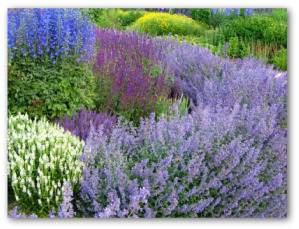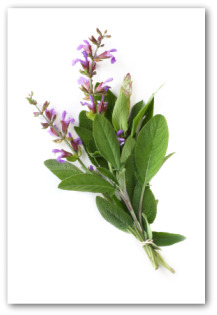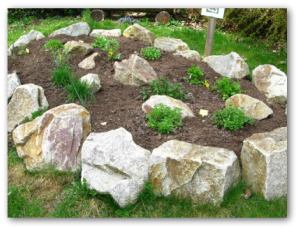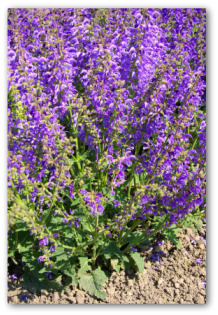
Tips for growing sage in an herb or vegetable garden. Learn how to plant, grow, start new sage plants, and harvest sage in your home garden.
This ancient herb is most popular as a food seasoning for meat, eggs, soups, gravies, fish, and Mediterranean dishes.
Sage is also a necessary ingredient for preparing the stuffing that goes into the Thanksgiving turkey!
Sage is an evergreen perennial woody plant with several stems, which branch up to about 2 ½ feet.
The shrub has a strong taproot and its soft leaves are gray-green, pebbly textured, lance-shaped, and finely toothed.
Spirals of lovely colored violet blue blossoms appear in the summertime.

Varieties of Sage
There are numerous varieties of sage.
The best culinary sages are the plain narrow leafed and non-flowering broad leaves types.
One or two plants should be sufficient for culinary use.
However, growing sage plants are also beautiful as ornamental plants in borders, flower, or vegetable gardens.
There are dwarf varieties that grow under the average three foot tall.
Some types of the herb are very ornamental such as Jerusalem Sage.
The leaves of this variety are sometimes made into a tea.
The yard high Holt's Mammoth is favored because it is fast growing and does not die back.
How to Grow Sage
Grow the herb in well-drained, rich soil, in full sun, and provide protection for the plants from cold winds.
Propagate by layering or from cuttings in spring and summer.
Layering is a foolproof method of encouraging the stem of a woody perennial such as sage to make roots of its own while it is still nourished by the parent plant.Hardy herbs like sage can be started by rooting several cuttings together in a small pot and then transferring them as a single plant.
Striking is a propagation technique where small cuttings are taken from the parent plant to create new plants.
Striking Cuttings for Sage

Caring for Growing Sage Plants
Pinch off tips of shoots to encourage bushy growth and keep the plants' compact for several months.
Trim growing sage frequently for best results.
Renew sage plants every 4-5 years as scrubs become spindly.
Mounding Sage to Start New Plants
Evergreen perennials such as growing sage can quickly develop into impressive mounds of shrubby growth.
When old woody herbs develop lower stems, they can be propagated by mounding.
Harvesting & Storing Sage

Medicinal Uses for Sage
The medical uses for growing sage include making sage flavored tea which counteracts sweating.
An infusion of the herb has been used in the past to treat anxiety, depression, and liver disorders.
Homeopathic preparations use the herbs as a remedy for menopause symptoms and poor circulation.
The leaves are antiseptic and can be used in gargles for laryngitis and tonsillitis; as a mouth freshener and teeth cleanser. http://www.vegetable-gardening-online.com/growing-sage.html
No comments:
Post a Comment